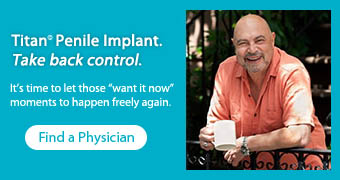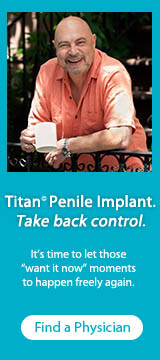I recently came across a write-up by Dr. Eid on his website regarding the axial rigidity of penile implants (see this link: https://www.urologicalcare.com/maximizing-penile-size2/, section “The issue of rear tips extenders”). Essentially, he notes that the non-inflatable rear portion of an implant is 4.5 cm for AMS and 5 cm for the Coloplast Titan, and the AMS version has a thinner (~9 mm) diameter. In a shallow 6–7 cm crus, this fixed rear segment may occupy most of the available space, bringing the junction between the inflatable and fixed portions very close to the point where the penis exits the pelvic bone. According to Dr. Eid, this junction isn’t very stable, and if it’s too close to the exit point, it can create a “hinge” effect and reduce axial rigidity. He also points out that adding rear tip extenders (RTEs) makes this issue worse.
His explanation seems logical, but I’d like to hear from anyone with a shallow crus about how this affects their implant’s axial rigidity—and thoughts on Dr. Eid’s assessment.
Implant axial rigidity
-
sambalamba
- Posts: 173
- Joined: Tue Jul 02, 2024 9:31 am
Implant axial rigidity
55 years. Using bimix 0.4 units. Works well but inconsistent and very inconvenient. Seriously considering an implant. 6.4 inches bone pressed length to tip, 5 inches girth base, 4.5 inches girth mid-shaft.
Re: Implant axial rigidity
I came across a section in a paper co-authored by Dr. Eid where he attributes the "wobble effect," caused by RTEs over time, to pressure atrophy, a concept I've heard discussed by prosthetic surgeons, even in the orthopedic field and in AUS discussions. Just highlighting a long-term component to RTE's wobble effect and I know it's different from what you're referring to.
Dr. Eid is a treasure trove of knowledge. I wish he would write a book before he officially retires!
Quoting the paper...
Penile prostheses form a pseudocapsule after implantation. For the inflatable component of the implant, inflation of the implant allows the material to fill the entire space within the pseudocapsule. However, anecdotally, we have found that the pseudocapsule around the non-expanding rear tips gradually dilates over time, and pressure atrophy with gradual compression of the surrounding cavernosal muscle and tunica thins out the flesh of the penis. The dilation may cause the device to “wobble” proximally, more so if more rear tips are used.....
Sexual Medicine Reviews journal, 2019 Jul
The Rear Tip Extender for Inflatable Penile Prostheses: Introduction of "Rigidity Factor" and Review of the Literature.
Thirumavalavan N, Cordon BH, Gross MS, Taylor J, Eid JF.
https://pmc.ncbi.nlm.nih.gov/articles/PMC6559880/[/i]
Dr. Eid is a treasure trove of knowledge. I wish he would write a book before he officially retires!
Quoting the paper...
Penile prostheses form a pseudocapsule after implantation. For the inflatable component of the implant, inflation of the implant allows the material to fill the entire space within the pseudocapsule. However, anecdotally, we have found that the pseudocapsule around the non-expanding rear tips gradually dilates over time, and pressure atrophy with gradual compression of the surrounding cavernosal muscle and tunica thins out the flesh of the penis. The dilation may cause the device to “wobble” proximally, more so if more rear tips are used.....
Sexual Medicine Reviews journal, 2019 Jul
The Rear Tip Extender for Inflatable Penile Prostheses: Introduction of "Rigidity Factor" and Review of the Literature.
Thirumavalavan N, Cordon BH, Gross MS, Taylor J, Eid JF.
https://pmc.ncbi.nlm.nih.gov/articles/PMC6559880/[/i]
40, Coloplast Genesis, 1/2025, Dr. Christine, UCAL
-
sambalamba
- Posts: 173
- Joined: Tue Jul 02, 2024 9:31 am
Re: Implant axial rigidity
Hi Lasthope,
I have come across this article. Thanks for posting again though. I agree Dr. Eid is a treasure trove of knowledge. He has a degree in material science engineering and takes an engineering approach towards the implant. Afterall it is a mechanically engineered device. Due to his advanced age I have decided to go with Dr. Clavell as my surgeon. I'm quite concerned about Dr. Eids advanced age and recent illness. Otherwise I would pick him in a heartbeat.
I have come across this article. Thanks for posting again though. I agree Dr. Eid is a treasure trove of knowledge. He has a degree in material science engineering and takes an engineering approach towards the implant. Afterall it is a mechanically engineered device. Due to his advanced age I have decided to go with Dr. Clavell as my surgeon. I'm quite concerned about Dr. Eids advanced age and recent illness. Otherwise I would pick him in a heartbeat.
55 years. Using bimix 0.4 units. Works well but inconsistent and very inconvenient. Seriously considering an implant. 6.4 inches bone pressed length to tip, 5 inches girth base, 4.5 inches girth mid-shaft.
Re: Implant axial rigidity
Good to know about Dr. Eid's training in materials science and engineering. Like you said, he does speak like a professor. I just wish he continues his legacy with more knowledge sharing after his retirement. There's no substitute for experience. His age and health can be a cause for concern, and I understand that. I'm impressed by his post-op support via text messages. In this age of 15-minute rushed appointments, this is a great thing offered by Dr. Eid and Dr. Clavell without even asking for it.
BTW, this lab study also seems to support Dr. Eid's article. I'll paste it here so it's here for easy reference.
https://www.auajournals.org/doi/10.1016 ... 17.02.1196
PD25-01 ENGINEERING BUCKLING FORCE STUDY FOR SUPPORTING THAT CYLINDER CONSTRICTION AND REAR TIP EXTENDER ARE ASSOCIATED WITH REDUCED AXIAL RIGIDITY – THE IMPLICATIONS ON CLINICAL PRACTICE
Paulo Egydio, Jeffrey Taylor, Grant Taylor, and
Irwin Goldstein
Journal of Urology
April 2017 , Volume 197 ( 4 ), p e502
INTRODUCTION AND OBJECTIVES
Inadequate axial penile rigidity may occur in some patients solely on the basis of unusual tissue mechanical and/or geometric factors, despite adequate intracavernosal (intraluminal) pressure values and sufficient hemodynamic integrity. The objectives were to study influence on cylinder distensibility and the rear tip extender (RTE) on axial rigidity.
METHODS
A penile model fixture and bucking test using Instron equipment was performed to evaluate bucking force vs cylinder constriction with 4 cm sleeve lengths with diameters of 11 and 12 mm and the effects of adding RTE (figures 1 & 2).
RESULTS
When the cylinder diameter is constricted with a sleeve the buckling force decreases (figure 1). Any cylinder with a 2 cm RTE performs worse than another cylinder of the same length without RTE’s. The 16 cm + 2 cm RTE buckles at a lower force (4 lb) than a 18 cm cylinder with no RTE’s (7.3 lb). With the 3 cm RTE’s the cylinders all perform nearly the same due to the fact that the cylinder base is out of the fixture and the taper leading into the base promotes buckling (figure 2).
CONCLUSIONS
A restriction at a localized area along the cylinder length decreases the buckling resistance. Using a longer cylinder without RTE’s is better than using a shorter one with RTE’s. Keeping the cylinder base deep in the crus improves buckling resistance.
BTW, this lab study also seems to support Dr. Eid's article. I'll paste it here so it's here for easy reference.
https://www.auajournals.org/doi/10.1016 ... 17.02.1196
PD25-01 ENGINEERING BUCKLING FORCE STUDY FOR SUPPORTING THAT CYLINDER CONSTRICTION AND REAR TIP EXTENDER ARE ASSOCIATED WITH REDUCED AXIAL RIGIDITY – THE IMPLICATIONS ON CLINICAL PRACTICE
Paulo Egydio, Jeffrey Taylor, Grant Taylor, and
Irwin Goldstein
Journal of Urology
April 2017 , Volume 197 ( 4 ), p e502
INTRODUCTION AND OBJECTIVES
Inadequate axial penile rigidity may occur in some patients solely on the basis of unusual tissue mechanical and/or geometric factors, despite adequate intracavernosal (intraluminal) pressure values and sufficient hemodynamic integrity. The objectives were to study influence on cylinder distensibility and the rear tip extender (RTE) on axial rigidity.
METHODS
A penile model fixture and bucking test using Instron equipment was performed to evaluate bucking force vs cylinder constriction with 4 cm sleeve lengths with diameters of 11 and 12 mm and the effects of adding RTE (figures 1 & 2).
RESULTS
When the cylinder diameter is constricted with a sleeve the buckling force decreases (figure 1). Any cylinder with a 2 cm RTE performs worse than another cylinder of the same length without RTE’s. The 16 cm + 2 cm RTE buckles at a lower force (4 lb) than a 18 cm cylinder with no RTE’s (7.3 lb). With the 3 cm RTE’s the cylinders all perform nearly the same due to the fact that the cylinder base is out of the fixture and the taper leading into the base promotes buckling (figure 2).
CONCLUSIONS
A restriction at a localized area along the cylinder length decreases the buckling resistance. Using a longer cylinder without RTE’s is better than using a shorter one with RTE’s. Keeping the cylinder base deep in the crus improves buckling resistance.
- Attachments
-
- Screenshot_20241229-031752.png (896.28 KiB) Viewed 710 times
-
- Screenshot_20241229-031857.png (808.06 KiB) Viewed 710 times
40, Coloplast Genesis, 1/2025, Dr. Christine, UCAL
-
sambalamba
- Posts: 173
- Joined: Tue Jul 02, 2024 9:31 am
Re: Implant axial rigidity
LastHope wrote:Good to know about Dr. Eid's training in materials science and engineering. Like you said, he does speak like a professor. I just wish he continues his legacy with more knowledge sharing after his retirement. There's no substitute for experience. His age and health can be a cause for concern, and I understand that. I'm impressed by his post-op support via text messages. In this age of 15-minute rushed appointments, this is a great thing offered by Dr. Eid and Dr. Clavell without even asking for it.
Very interesting. Thanks for digging it up and posting. I don't quite get what the sleeve means in the study. Seems to me this is trying to mimic the crus with a 4 cm depth and 11mm and 12mm diameter. Would that be accurate?
Looks like in the sleeve vs non-sleeve study, at 22cm, the buckling force is around 2.5 lbft which is 11 newtons.
You had also posted this study numbers before. Based on the numbers this is still good enough for vaginal but not for anal.
Of course the caveat in the study is that it is done outside of the corpora so things could work differently inside. But still paints a good picture.
On a completely separate note, I see that you are using ICI. Which one are you using and what amount? Do you know how to increase effectiveness of the injections. When I inject I tie a rubber band around the base to try and keep the fluid inside the corpora and then rub the crus and the entire shaft. Only problem is when I tie the rubber band around the base loose skin kind of piles up nearby and sometimes the needed doesn't perforate the tunica.
55 years. Using bimix 0.4 units. Works well but inconsistent and very inconvenient. Seriously considering an implant. 6.4 inches bone pressed length to tip, 5 inches girth base, 4.5 inches girth mid-shaft.
Re: Implant axial rigidity
No Rigicon shown I see ..perhaps it was posted before they came on the market in 2019 .. that's 6 years back much has changed ... I would think it would depend on the rod size ..mine are 13mm and I don't think I would have any issues with anal unless it was extremely tight.
Rigicon since 6-2023 happy to share my experience and do show and tell
Re: Implant axial rigidity
sambalamba wrote:Very interesting. Thanks for digging it up and posting. I don't quite get what the sleeve means in the study. Seems to me this is trying to mimic the crus with a 4 cm depth and 11mm and 12mm diameter. Would that be accurate?
Looks like in the sleeve vs non-sleeve study, at 22cm, the buckling force is around 2.5 lbft which is 11 newtons.
Screenshot 2024-12-29 122831.jpg
You had also posted this study numbers before. Based on the numbers this is still good enough for vaginal but not for anal.
Of course the caveat in the study is that it is done outside of the corpora so things could work differently inside. But still paints a good picture.
Yes. However, for anal penetration, relaxing the sphincter and using lubrication helps overcome the higher penetrative resistance and overcome buckling issues. I've heard this from surgeons. I've also seen a video of a gay pornstar who switched from AMS to Coloplast to optimize the axial rigidity for anal penetration. He didn't complain about anal penetration with AMS, but he was terribly upset that his surgeon didn't explain to him about axial rigididity variances between models.
40, Coloplast Genesis, 1/2025, Dr. Christine, UCAL
Re: Implant axial rigidity
sambalamba wrote:On a completely separate note, I see that you are using ICI. Which one are you using and what amount? Do you know how to increase effectiveness of the injections.
My Trimix dose is 25 units. I'm still a newbie to Trimix and only use it once in a while out of curiosity and to get a good stretch. I'm not liking the recommended frequency. I'm sure I will overdo it and end up with fibrosis and Peyronie's with more than recommended use.
The pro guys who use Trimix frequently recommend these strategies:
-Get a chubby with a VED to make it easy to inject in the correct spot and for a quicker erection
-Use a cock ring
-Massage the injection area
-Stimulation is key, no matter the dosage
40, Coloplast Genesis, 1/2025, Dr. Christine, UCAL
Re: Implant axial rigidity
easymoney wrote:No Rigicon shown I see ..perhaps it was posted before they came on the market in 2019 .. that's 6 years back much has changed ... I would think it would depend on the rod size ..mine are 13mm and I don't think I would have any issues with anal unless it was extremely tight.
Yes. Rigicon got FDA approval in 2019 but really only took off around 2021 in the US market. Their brochure says 6.6 lbs, which is 31N. The average anal penetration force studied is 30.3 N, with a range of 16-52N, and sure, 52N on the tighter side can be an issue, like you suspect, but hey, that's why God has created lube!
40, Coloplast Genesis, 1/2025, Dr. Christine, UCAL
Who is online
Users browsing this forum: Sycamore and 54 guests







